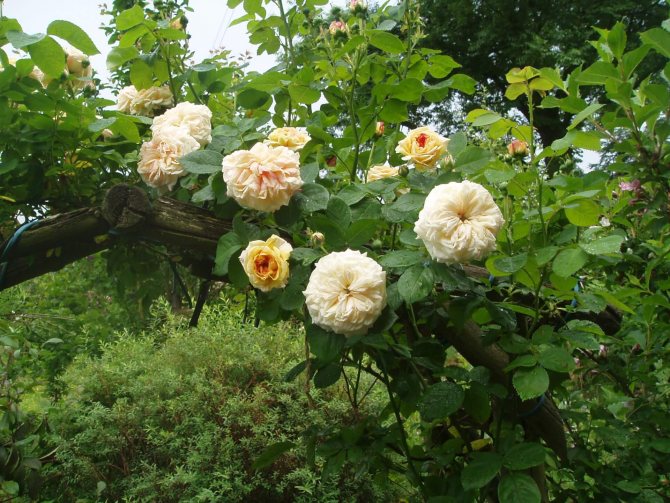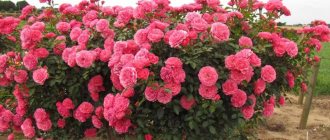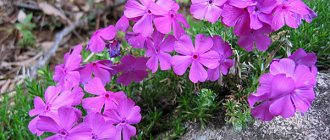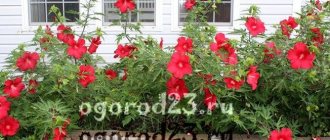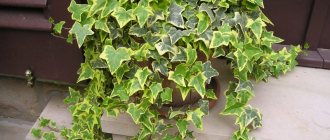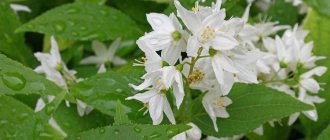Breeders all over the world are constantly in search of new groups and varieties of roses that would not only look and smell beautiful, but also tolerate the frosts of central Russia well. Scrub roses have become a real breakthrough in this area, and although they have to be sheltered for the winter, they are quite frost-hardy and tolerate the cold very well.
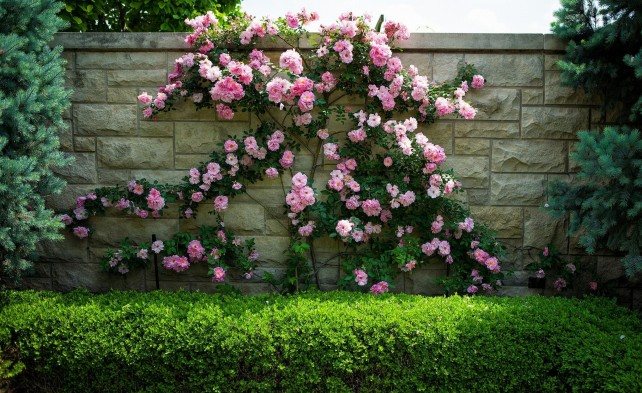
In English, a group of roses sounds like "shrub", which means "shrub". All roses in this group are shrubs. They are characterized by:
- Wide variety of colorsranging from common tea hybrids to the floribunda group. As for the color of the plant, the photo shows that it can also be varied.
- Abundant lush bloom... Each plant variety blooms for a long time from early summer to autumn. Almost all varieties are re-blooming, but there are also single-flowered roses (Fritz Nobis variety).
- Scent... Almost all varieties have a pleasant expressive aroma.
- The size... Representatives of the group are characterized by strength and height (some varieties reach two meters).
- Frost and pest resistance... Unlike many other roses, shrubs do well in winter and require only a little protection during the cold season.
- Unpretentiousness... According to the description of many varieties, it can be understood that even novice gardeners can grow shrabs.
- Possibility to combine with other roses... Shrubs are suitable both for single cultivation and for planting in groups of three to five bushes.
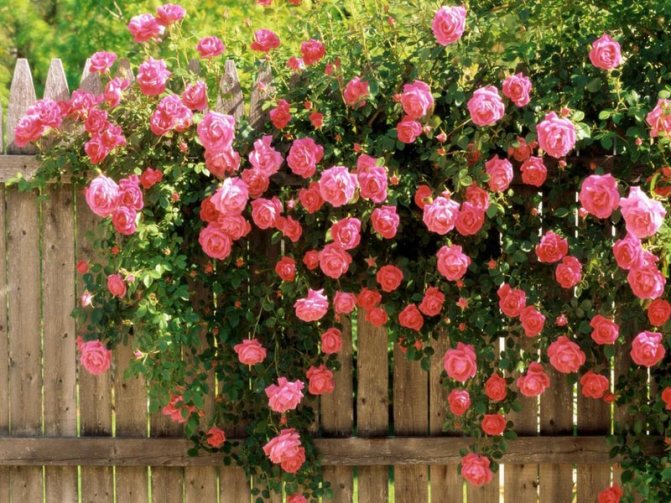

If you plant several bushes, you get the feeling of a large green ball with roses, and those irregularities that are in the bush are hidden by neighboring roses.
Brief biological description
Floribunda (lat. Floribunda - "profusely blooming") - a group of varieties of roses, singled out separately in 1976, as an intermediate link between polyanthus and hybrid tea roses.
The authorship of the selection is attributed to two originators at once: the American P. Lambert and the Dane St. Poulsen, who conducted experiments on crossing at the beginning of the 20th century. The many varieties of floribunda roses familiar to us today were bred by the famous rose breeder Yevgeny Brener in the 40-50s. Currently, there are more than a hundred floribunda varieties and work continues to create new ones.
Important! Recently, in the specialized literature, floribunda is often called "grandiflora", in relation to varieties that give especially large flowers.
Features of hybrid tea roses
Hybrid tea crops are very popular among flower growers. They emerged from the teahouse and remontant roses. This category is often used to create bouquets. The inflorescences are characterized by the correct shape and delicate aroma.
When decorating a garden, bushes can be used alone or in groups. A characteristic feature of such crops is the shade of the leaves. They are green in color with a reddish tint. Such bushes have 1 flower per branch. They are large in size and reach 10-12 centimeters in height.
Plants need proper care. Thanks to this, common diseases are avoided. The bushes are characterized by resistance to frost down to -18 degrees.
In regions with harsher climates, plants should be covered for the winter.
Appearance
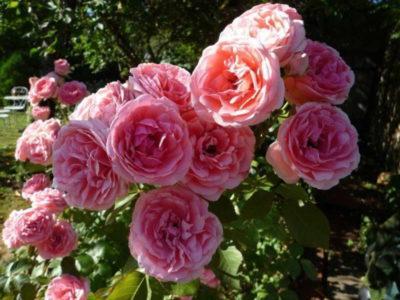

In the group, there are border (up to 40 cm), medium-sized (50-80 cm) and high varieties (from 1 meter). The bushes are straight or spreading. Floribunda foliage is dense, smooth or veined, dark green, glossy, varieties with matte leaves are rare. Leaves (5-7 pieces) are attached to the petiole, connected by nodes with lateral shoots or stem.
A distinctive feature of floribunda is the flowering of not single flowers - several buds bloom at once, collected in racemose inflorescences. Large flowers have different colors depending on the variety, usually bright and juicy.
There are flowers of varying degrees of doubleness (10-25 petals), less often simple ones. Many varieties are close in shape to hybrid tea roses - they have a goblet bowl, others are cupped or flat. Unlike hybrid tea varieties, floribunda flowers either do not smell at all or give a faint aroma.
We want to introduce our readers to the varieties Pink Mondial, Jubilee of the Prince of Monaco, Aspirin, Novalis, Pink, Pomponella, which you can read about in our articles.
Roses shrabs - what are they?
A person who speaks English will easily determine the meaning of the word "shrub": in translation it simply means "shrub". This definition in relation to roses appeared relatively recently - around 1965. There are completely non-fictional legends about the endurance and resistance to frost of this type of rose. So, the Canadian variety of shrab, described for the first time in the 70s of the last century, is capable of withstanding low temperatures - up to -40 ° C.
Scrub roses are considered park roses. Plants that have not found their place in other groups, but have high frost resistance, are also automatically classified as scrub plants. The main criterion is the endurance of harsh weather conditions, namely low subzero temperatures. Another characteristic was the decorativeness of the species: there are many varieties in shape (can be small, large, growing in breadth, looking like a fountain) and color.
Translation from English "bush rose" does not convey any distinctive features of the species, since any rose grows in the form of a bush. The variant using the English word came from Europe and was successfully adapted in Russian as a term. But the form still has its own characteristics, when describing it, the following should be highlighted:
- all varieties of scrubs are bush-shaped;
- rich palette of colors;
- this species includes many varieties, ranging from tea hybrids to constantly blooming floribunda roses;
- noteworthy is the persistent pleasant aroma of the buds, which has different subtle accents;
- tall varieties of bushes can grow up to 2 meters;
- get along well with other types of roses and various garden flowers;
- the main distinguishing feature is frost tolerance.
How is it different from scrubs?
Shrabs (English shrub - lane. "Shrub") - tall varieties of park rose shrub type, which are characterized by long continuous flowering. Scrubs include all complex hybrids, which, for a number of reasons, cannot be attributed to floribunda and other varieties of roses. Shrubs are similar in appearance to floribunda: they give shrubs with a large number of flowers in various shades and shapes.
The difference between scrubs and floribundas is that the former are more hardy, but they bloom less abundantly, since a lot of the plant's resources are spent on forming a tall bush. Also, a distinctive quality of scrubs is the rich aroma of flowers.
Scrubs in landscape design
Due to their impressive height, shrubs are highly regarded by designers from all over the world. Such a plant can be planted in almost any corner of the site, and at the same time it will not require any special care.
They also create hedges from many tall varieties, but there are also curb shrubs that are planted along the path. And shrubs are planted next to lavender and fennel, and it looks very dignified.


Rose bushes also look interesting with plants with large foliage, which designers use with success.
The decoration with flowers will depend on the type of scrubs. For example, if we talk about English varieties that resemble large peonies in shape, then they are best distributed in single plantings.
Thanks to the shape of English scrubs, their stems, covered with buds, hang down to the ground - as a result, the bush resembles a large ball in shape. If you choose bright varieties of flowers, then with their help you can emphasize the juicy green of the lawn.
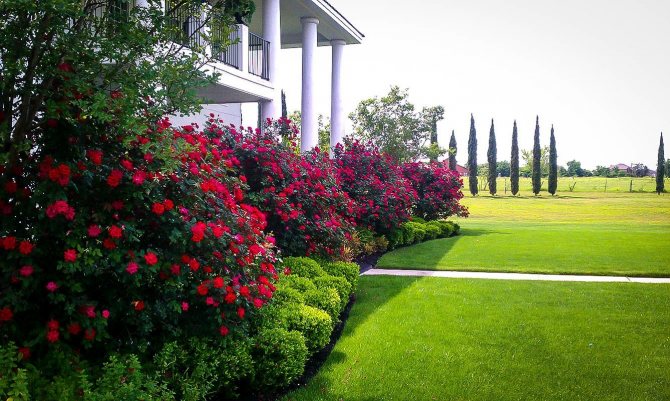

It was mentioned earlier that shrubs are used as hedges in the garden. With their help, you can focus only on a separate area, or plant shrubs around the perimeter. In this case, you can even forget about the formation and pruning of the shrub.
Having planted indoor varieties of scrubs in front of it, you can decorate with them evergreen shrubs and trees... Shrubs are combined with thuja, juniper, spruce, fieldfare, etc.
In the case of semi-pebbled types of scrubs, it is appropriate to use them for vertical gardening. In just one season, roses can cover an entire wall. If we talk about large varieties, the bushes of which look voluminous during flowering, then it is appropriate to decorate gazebos, terraces or arches with them.
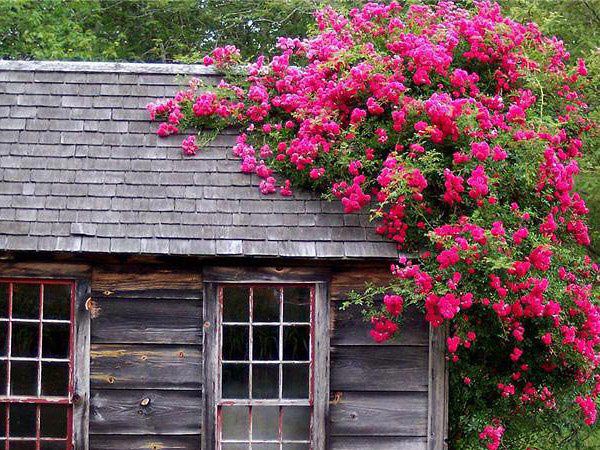

Ground cover roses are appropriate to use for decoration of gentle slopes, or near borders (that's why they are called "border" roses). This scrub Westerland (Rose Westerland), rose Caramella (Caramella) - exactly it you can see in the title photo, Kentucky Derby (Kentucky Derby) and others. It also makes sense to place such varieties in flowerpots, artificially raising the whip of roses above the ground. If you form a bush correctly, then it will be an excellent "bonus" to rockery or lawn.
Life span
The average life span of floribunda bushes is 8-12 years.
The life of the bush is extended due to systematic rejuvenation - special pruning of old, "blind" and dead shoots. It is useful to replant old bushes periodically. Having dug out a previously pruned bush, you should examine its root system and remove dry or diseased roots, and cut off too long roots.
Combined with proper farming techniques, pruning and replanting a bush can extend its life by 10 years.
Important! The life span of a bush and its flowering also depends on the quality of the seedling itself.
Landing technology
From the technical point of view, planting any rose is about the same. Slight differences can be observed in the planting of seedlings with open and closed root systems. Plants from the pot are planted with a lump of earth, and with open roots placed in water for several hours so that the roots are saturated with moisture. For the rest, there is no difference, and planting rose scrubs in open ground occurs in the following order:
For the first time, the bushes should be shaded with spruce branches or other material. Further care of roses consists in periodic watering, dressing, forming pruning.
Names of popular varieties with photos
Carte Blanche
White, with a slight shade of pink, goblet buds.


Bluvender
Blue and pale lilac flowers.


Samba
Yellow petals with red edging, which, as they bloom, acquire a bright scarlet color with yellow veins.
Lilly Marlene
Weak double fiery red flowers.
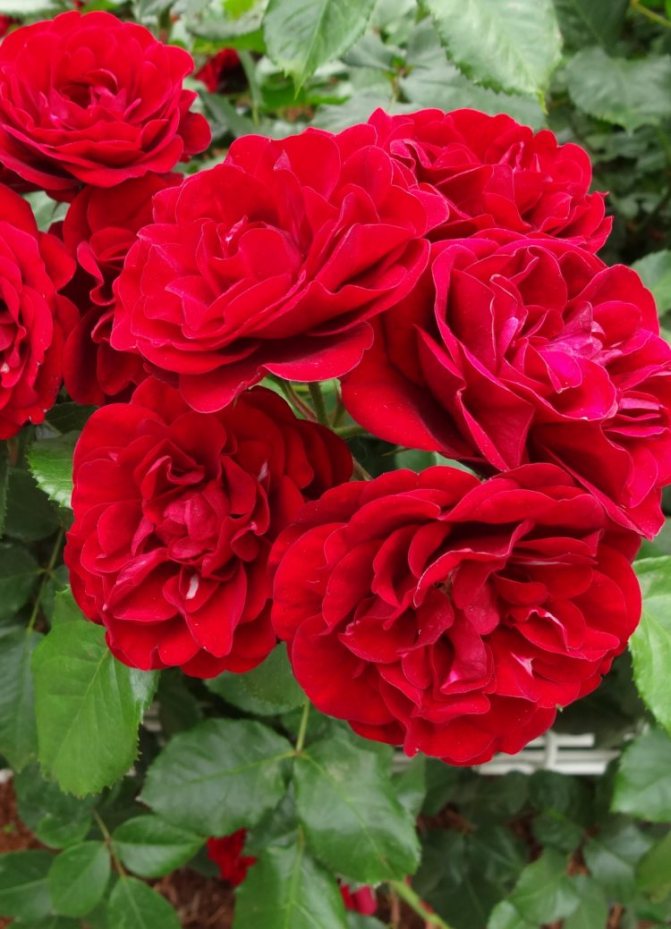

Freesia
Terry buds of a pale yellow hue.
Purple tiger
The bud is colored with a mixture of white and purple-lilac with pink and lilac spots, streaks and streaks.


Rosemary Rose
Camellia-shaped flowers with pinkish-currant color.


Varieties of rose scrubs with photos and descriptions
Here are some varieties with reviews from experienced gardeners with photos and descriptions.
Magnet Shrub variety Is a classic bush rose, characterized by delicate pink flowers and high aroma. Flowers are multifaceted, reaching 9 cm in diameter, with wavy petals. The color of the rose is multifaceted, changing from pale pink to peach and salmon. Reviews of experienced gardeners speak in favor of the fact that the rose bush is powerful, tall, reaching 100 cm, the flowers take root well and bloom for a long time.
Another variety -La Villa Cottawith pink petals on the outside and copper ones on the inside. Characteristics: healthy, glossy lush green foliage that perfectly sets off the flowers of the beauty. There is a delicate aroma, flowering, delighting the gardener throughout the season. The bush is erect, does not require additional support, strong and rather fluffy. It tolerates frost well and is resistant to many diseases, especially powdery mildew. As the gardeners' reviews say, the plant perfectly tolerates not only frosts, but also heat up to 40 degrees. But it is hard to get accustomed, for a long time "adapting" to a new place.
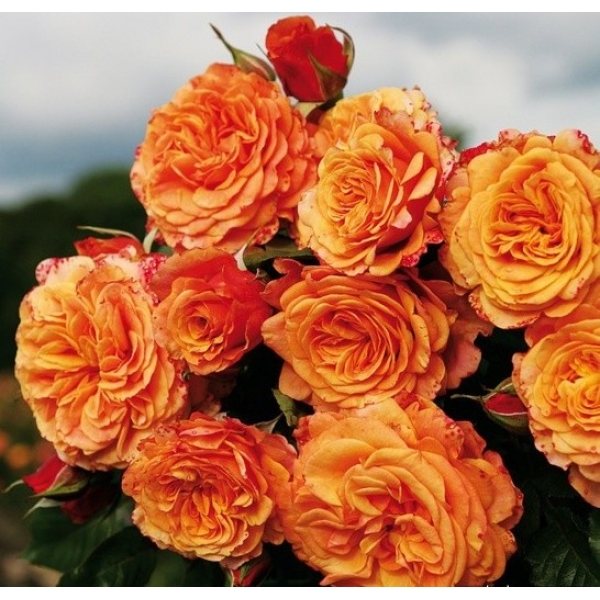

If you are a lover of bright, juicy flowers, you will like the variety Red Eden Rose (Red Eden Rose) with double flowers and a bright garnet shade, which fades towards the end of summer and turns into crimson. The bush of the plant is strong, tall, blooms with large flowers, collected in a brush of several pieces. Red Eden Rose tolerates winter well and is resistant to various diseases (powdery mildew). In addition, gardeners note the breathtaking scent of this rose, with hints of fresh fruit.
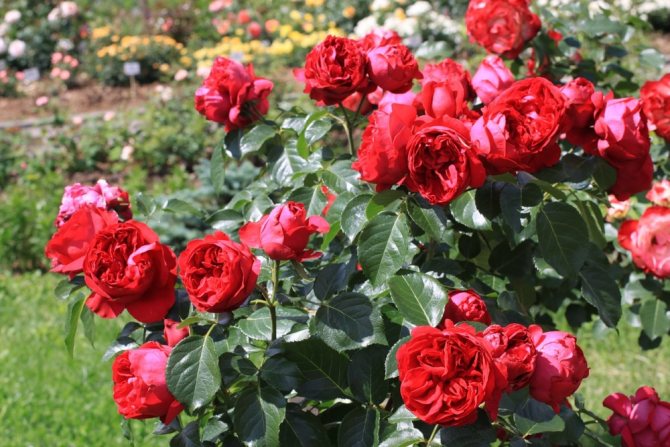

A stunning variety - Belvedere Shrab Rose (Belvedere), with large peach-colored flowers. Looks best in small groups of three bushes. The aroma is pleasant, tart, bright. However, as many gardeners note, it is susceptible to many diseases. Including powdery mildew.
The owner of juicy pomegranate flowers is an English variety Fisherman s Friend (Fisherman's Friend) with a bright scent of rose oil. Not resistant to diseases inherent in roses, but perfectly tolerates frosts. It has a tall, powerful bush and flowers up to 15 cm in diameter. As many gardeners note, it tolerates winter perfectly, even if the bush is not covered.
rose flower Kennys Shrub also deserves attention. It is characterized by beautiful, pink flowers, similar in color and size to a peony. The bush grows up to 90 cm in height, 60 cm in width. Flowers with a fresh tea aroma, during aging begin to smell like lemon, and later - black currant. As gardeners note, such metamorphoses occur with a rose not only after aging, but also with the transition of day and night. Many people love this variety for its bud size and unique aroma.
There are other, more classic varieties of scrubs. This is the grade Fluorescent (Rose Fluorescent), bred back in 1977. It is characterized by bright scarlet flowers that delight their owners with constant flowering. As gardeners note, the bush tolerates rain well, but practically does not please with the aroma.
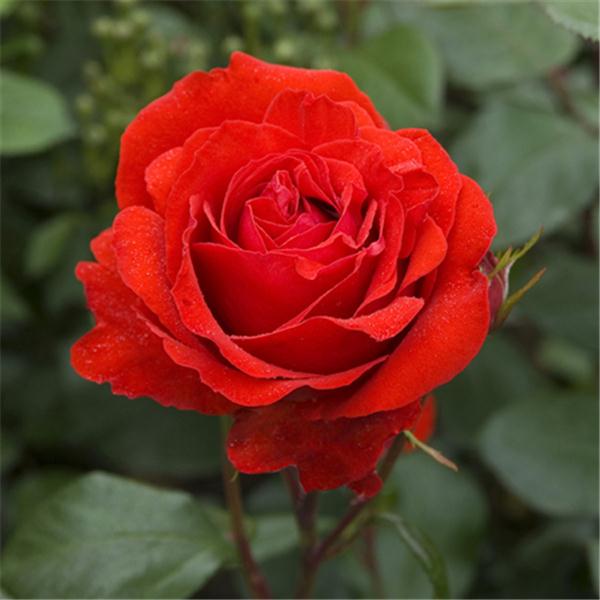

Another mind-blowing type of scrubs is Romance (Romanze)... It is characterized by bright pink flowers, collected in inflorescences up to 15 pieces in a panicle. It has a pleasant, bright aroma and a tall bush up to 150 cm. As gardeners note, the plant is a universal plant for beginners, which is characterized by paradoxical endurance and will survive any bad weather, from rain and frost to extreme heat.


It would be a shame not to mention such a beautiful view as Bonanzawith petals of different colors. Inside the flower is sunny orange, and outside it is pink. Inside, with full disclosure of the flower, golden stamens are observed. This type is also good in that it has cleaning properties, since it is cleared not only of the petals on the flower, but also of the leaves on the trunk, therefore it does not need pruning. As gardeners note, the scrub blooms for a very long time, almost until the very frost.
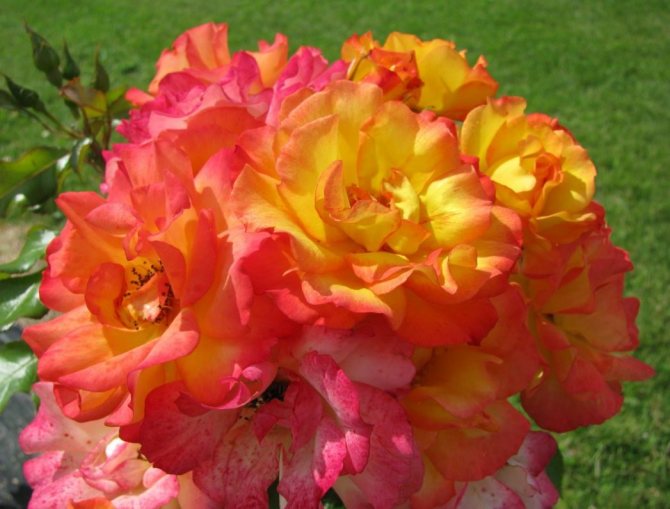

The variety is characterized by stunning white flowers. Snow Balletcreated by two breeders at once. Over time, the flowers turn into a green hue and delight their owners with the same delicate aroma as the flowers themselves.The bush is very lush, up to 120 cm in diameter, in color from early spring to late autumn. According to gardeners, even the seedlings of this shrab tolerate frost well.


Another variety of flowers from the famous Austin breeder is the scrub William Morris, named after the eponymous poet and artist William Morris. It is beautiful already in that several colors seem to be specially mixed in it - luminous pink, juicy peach and bright apricot. During the season, the bush blooms several times, each time abundantly. As gardeners note, over time, under the weight of flowers, the bushes bend to the ground, so they need support.
How to choose a plant when buying?
It is better to purchase seedlings in the form of roots with peat, packed in bagsthan a ready-made rose in a container, which is more difficult to adapt to the conditions of the garden.
When choosing a bush, you need to make sure that it has:
- there are several stems no thinner than a pencil;
- stems lignified, green and unwrinkled;
- the roots are well developed and branched;
- no young buds and shoots on the stem.
Read more about the varieties and types of Floribunda roses here.
Do I need insulation for the winter
For all its endurance to low temperatures, frost-resistant scrub still needs insulation. If in the southern regions it is enough to pay attention to the roots of the plant, covering them with sawdust or fallen leaves, then in the more northern parts this will not be enough. It will take the construction of a shelter for the bush itself in the form of a greenhouse from a suitable material.
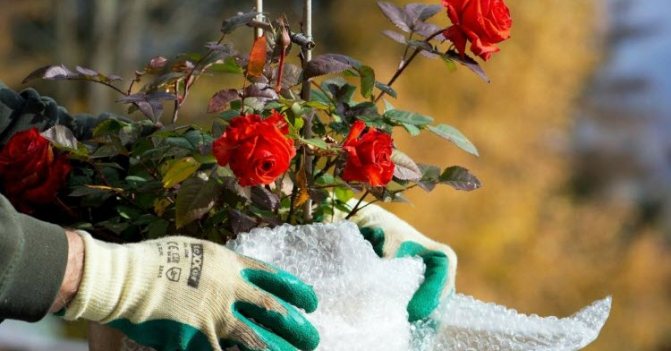

Usually how roses are insulated
Landing
Determining the method
Seeds are a laborious and unproductive method with a low percentage of germination; they can be bought or collected from an existing bush. The seeds are pecked for several months, then planted in the ground and the seedlings are germinated for another couple of months. It is advisable to grow miniature varieties in a similar way.
Saplings - predominantly picked from shops or nurseries. Seedlings are chosen in winter and kept dormant until spring; in spring, the plant is shortened and prepared for planting in a pot or in open ground.
Soil preparation
The soil should be non-acidic, well-drained and breathable. The soil should consist of a mixture:
- clay;
- humus;
- sand.
The main quality of the earth is its richness in organic nutrients.
Important! It is recommended to add bone meal and superphosphate fertilizers to the mixture.
Pot selection
A plastic or earthen pot with holes in the bottom and a tray to collect excess water works best. A small floribunda requires a pot of at least 38 cm in diameter; for larger specimens, volumetric pots from 50 cm in diameter are selected.
Process
- In the pot:


A drainage layer (3 cm) is laid out at the bottom of the flowerpot, then the container is 2/3 filled with the prepared soil mixture. - The existing planting material is placed in the middle.
- Then the rest of the soil is added, which should fill the container almost to the brim.
- After planting, the soil is abundantly watered and loosened.
- In open ground:
- When planting a plant on a flower bed, it is necessary to dig a deep hole (40-50 cm).
- Moisten it and place the seedling vertically in the center of the hole.
- Then the seedling is buried in the remnants of the soil and watered abundantly.
Use in landscape design
Floribunda is widely used in landscaping... It mainly forms the edges of lawns and hedges. Due to the fact that there are many varieties of different heights and colors, you can create a full-fledged multi-level garden composition of any complexity from floribundas.
Also on our portal there is information about the varieties of roses Mona Lisa, Pink Floyd, Nina Weibul, Midsummer, Leonardo da Vinci, Coco Loko, Pomponella, Novalis, Aspirin.
Landing in open ground
Most varieties of scrubs are propagated by grafted seedlings, for some varieties a vegetative method can be used.Planting roses can be carried out both in spring and in autumn, it all depends on the climate of the region and the variety of roses. In the southern regions, planting in autumn is possible, but in temperate and northern latitudes, spring planting should be preferred. You also need to take into account the varietal characteristics of the shrub, since there are more or less winter-hardy varieties.
For planting, you can use seedlings with an open root system or closed (in pots), while transplanting roses from a pot can be carried out throughout the summer season. As for grafted seedlings with open roots, they are usually sold and purchased in the fall. If the climate in your area is such that outdoor planting can only be done in the spring, then simply store the seedlings in a cool place until spring. They can be dug in or wrapped in a moisture-consuming material, for example, sphagnum moss, which will need to be periodically moistened.
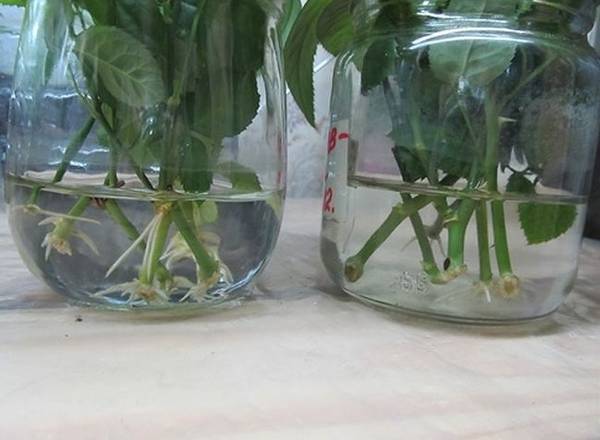

The place for planting roses should be open to the sun and protected from northerly winds and drafts. It is best to plant bushes on the south or southwest side of the site. Wetlands with a high level of groundwater should be avoided - roses do not tolerate excessive moisture. The quality of the soil for scrubs is not important, the main thing is that the soil is not heavy and sour. Loose loamy soil with good drainage properties and neutral acidity is considered the most suitable for roses in this group. Organic fertilizers will help to improve the quality of the soil: compost, humus, wood ash, which are brought in for digging.
When planting shrubs, keep in mind that many of them have a fairly powerful crown and root system, so if a transplant becomes necessary, it will be very difficult to do this. To avoid transplanting, you must initially clearly understand the purpose of the roses and immediately think over the arrangement of the bushes:
Among the scrubs there are also climbing varieties and the so-called roses - fountains. Their planting depends on the size of the bush. "Fountains" have a beautiful spherical crown and look very impressive when planted in groups of 3, 5 bushes. Creeping or ground cover varieties can be planted almost everywhere: along walls, fences, verandas, arbors, decorative arches. They look great on slopes, cascading flower beds. In a word, among the scrubs, you can always choose a variety to your taste and plant greenery on any site.
Care
Conditions of detention
- When growing a plant in a garden area, you need to choose a bright place that would be shaded during the day.
- The rose does not tolerate direct sunlight on leaves and flowers.
- The site should not be in a swampy area and be heavily blown.
Reference. Since floribunda is a winter-hardy plant, it tolerates harsh climatic conditions well.
Watering
- Abundant watering is recommended during the growth of the bush, with it the frequency of the procedure is up to 2 times a week.
- Rare watering is required for floribunda bushes in the fall - at this time, the plant is irrigated no more than once every 2 weeks.
- In winter, in Central Russia, watering rose bushes in the open field stops, since there is no need for it during this period.
Floribunda is a moisture-loving plant, but excessive moisture and stagnation of liquid in the soil should be avoided.
Top dressing
Organic and mineral fertilizers are applied once in the spring and 3-4 times in the summer - to stimulate the flowering of the bush.
Pruning
A must for normal plant growth.
- In the spring, all frozen and damaged shoots are pruned and the crown of the bush is formed.
- Sanitary pruning is performed at the end of autumn.
Garter
Reference. Floribunda bush with normal development does not require additional support and garter.
If the bush is formed in an undesirable way or tilts to the ground, a peg is driven into the soil and the bush is tied with a rope to the support.
Transfer
A rose bush is transplanted in several cases:
- during the initial planting of a seedling;
- if necessary, in the rejuvenation of the old bush;
- if the floribunda does not take root in the selected area.
When transplanting, it is important not to damage the roots of the bush when digging up, otherwise it is necessary to follow the general rules for planting a plant.
Preparing for winter
- Autumn is a crucial time for a grower: to prepare floribunda bushes for hibernation, roses are cut to the size of a shelter.
- Further, floribunda bushes are spud and fed with organic fertilizers, which is necessary for the most comfortable wintering.
- Finally, rose bushes are spud with peat, covered with spruce branches and on top of it - with a durable non-woven material.


More details about growing and caring for Floribunda are described here.
Shrub pruning
Pruning roses is an essential prerequisite for their health and longevity. The main pruning is necessary during preparation for the winter period: young shoots are removed, which retain a large amount of moisture, which will turn into ice at sub-zero temperatures and damage the plant.
It is necessary to remove green leaves and remaining buds, as well as all branches that are damaged by any disease (this will save the bush from fungal formations in a closed greenhouse). The shoots weaving from below are just enough to neatly lay and cover with the root. Only long straight branches are left, because it is in them that all the strength and power of the bush is concentrated for growth and flowering.
Spring pruning is equally important. All damaged areas must be removed. The longest main shoots are pruned by one quarter, and those that extend to the sides are shortened by one third.
Important! The bush can have many long shoots, in which case it is important not to disturb the bush-like shape when pruning. A simplified or gentle pruning of one third of each branch is recommended. Low-growing plants lose half of each shoot.
After 3 years, adult roses need rejuvenation. To do this, at the very base, all old branches are removed, opening the way for the young, who will have time to get stronger and form a full-fledged rose bush before winter.
Bloom
Depending on the variety, the floribunda rose blooms either continuously or in waves in 3 stages, from the beginning of summer until the first frost. Floribunda blooms not only for a long time, but also very abundantly and magnificently.
A rose may not bloom for several reasons. It:
- Weak or diseased seedlings - require careful maintenance.
- Incorrectly chosen planting site - the bush can be transplanted to a new site.
- Insufficient or untimely pruning of the bush and removal of faded buds - you need to correct pruning, according to the recommendations.
- Improper feeding - Apply the correct fertilizer.
- Invasion of pests or the development of diseases - carry out preventive spraying and feed the bush.
How to grow on a windowsill
The class of scrubs is so diverse that there was a place in it for varieties of decorative roses that can be grown indoors on window sills and balconies. In principle, any rose can grow indoors (pot, container), so it is not necessary to select special indoor roses, you can plant any variety you like. Despite the fact that such roses are quite miniature, they also have a beautiful bush shape and are famous for abundant flowering, and the bushes can bloom all year round.
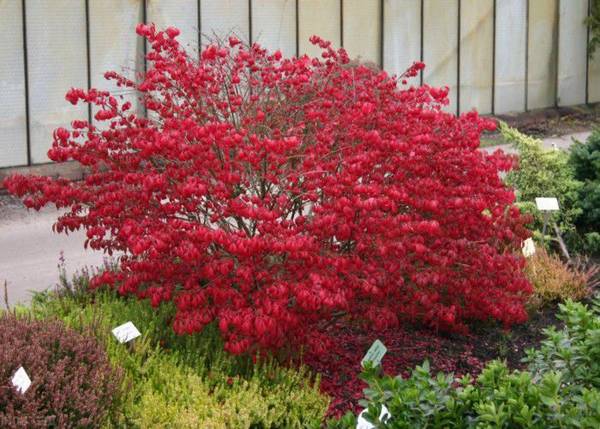

Among the scrubs there are also miniature climbing roses: Red Cascade (bright red inflorescences), Hi-Ho (coral-red buds), Green Ice (terry buds white with a greenish tint), which look great in pots, hanging pots.
They quickly braid balconies, verandas, creating a pleasant coolness and shade. For the winter, they can be brought indoors, cut off, and in the spring they will quickly unravel again.In short, growing roses at home in pots is simple and very exciting.
The easiest way is to purchase an indoor rose from a flower shop, and then just care for it and enjoy the abundant flowering. But if you are even a little interested in floriculture, then you will definitely want to plant and grow a beautiful flower with your own hands. If you decide to take this step and purchased a seedling, then you should not immediately transplant it into a new pot. First, let the plant get used to the indoor climate. You should also do with a seedling with open horses purchased from the market. Moisten the roots, wrap them, for example, in sphagnum moss (it keeps moisture well), and let the seedling stay in the room for two days.
The rose should be planted in a special substrate, which is sold in the same flower shop. You can independently prepare the substrate from peat, coarse sand, humus and garden soil in equal parts. The rose does not tolerate stagnant water, so drainage must be laid at the bottom of the pot. A plant bought in a store, as a rule, is in a peat substrate, which must be cleaned from the roots during transplantation, taking care not to damage them. By planting a flower along with a peat substrate, you doom its roots to dry out quickly, which can adversely affect the development of the plant.
Like all roses, indoor varieties love the sun, so it is best to place the pot on a windowsill in the south side of the room. In winter, the flower needs to be highlighted. A lot of sun does not mean that the plants can be hot - the optimal temperature for roses is + 15-20 ° C. You need to water the flower as the soil dries. To keep the roots always moist, pour water into the pan of the pot. For irrigation, use settled or filtered water at room temperature. In the summer, as well as when the heating is on, the bushes need to be sprayed with water daily.
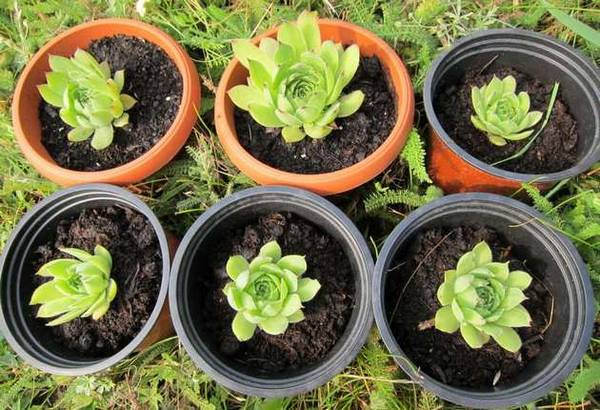

In general, caring for a room rose is no different from a garden rose. She also needs to be fed periodically. The rose loves organic matter, so more often indulge it with special complex fertilizers for roses with humates. During flowering, you need to feed at intervals of 2 weeks. Remember that the home rose also needs rest. In the fall, when the buds have faded, cut the shoots to a few centimeters, suspend feeding, water very rarely, just so that the shoots do not dry out. With the arrival of spring, resume watering and feeding, and the rose will immediately grow, and in a month it will give many buds.
Diseases and pests


Floribunda is characterized by diseases common to all types of roses:
- black spot;
- rust;
- powdery mildew.
Pests that threaten this type of flowers:
- bronze;
- aphid;
- rosy sawyer.
Comprehensive control is required against pests: they must be removed manually from the plant and the bushes must be treated with insecticides and decoctions.
Disease prevention
The endurance and resilience of the bushes does not mean that they are not subject to any diseases at all. Yes, and for pests, they still have not come up with a panacea.
Roses scrubs can be threatened by all those misfortunes that are characteristic of other garden flowering plants, they are just more hardy and easier to tolerate diseases. Diseases are detected by a simple way of regular examination.
Note! Of the pests, aphids are most often attacked by shrabs. If there are few insects, then it is recommended to remove them manually without resorting to chemicals, otherwise you need to use Karbofos or alternative methods, for example, spraying the bushes with a solution of laundry soap.
Preventive measures are best taken in the spring and fall. For spring procedures, spraying or dousing the bush (before the buds open on it) with copper sulfate (three percent solution) is suitable. In the autumn, ferrous sulfate is used in a one percent solution.
Shrubs are ideal for novice gardeners or just lovers of rose gardens: they are frost-resistant, have a strong immunity to powdery mildew and black spot, which so often affect other varieties of roses, are unpretentious in maintenance, look very impressive on a garden plot, and grow quickly.
Prevention of various ailments
It is recommended to use:
- Pruning affected and weak shoots.
- Removing dead buds and foliage.
- Top dressing with potash and phosphorus fertilizers.
- Spraying with drugs of a wide spectrum of action:
- Speed;
- Fundazol;
- Alirin-B;
- Topaz, etc.
- Spraying with copper-containing preparations before sheltering the plant and in early spring.
- Powder the bush with wood ash.
Important! The best disease prevention is quality plant care.
Floribunda is one of the most unpretentious representatives of bush roses, which can be grown without much hassle even in unfavorable climates. Therefore, even novice rose growers can engage in the cultivation of floribunda.
Variety of species and varieties
Shrabs have their own subgroups:
- Nostalgic shrubs. These include varieties of English, French and German landscape roses as well as landscape roses. One of the popular varieties of this subgroup, for example, is the William Shakespeare 2000, which is part of the Austin series of nostalgic scrubs.
- Canadian roses are semi-climbing. They have a particularly high frost resistance - up to -40 ° C. Cuthbert Grant is the most famous variety.
- Ground cover, or creeping country scrubs. This subgroup differs sharply from the others in that it has lashes spreading creeping along the ground. Bushes can be both small and large, large-flowered and with small buds. The Summer Morning variety is often used for border decoration.
Interesting! The unpretentiousness of care and the survival rate of scrubs in any weather conditions interested many scientists-breeders. In this regard, a large number of varieties of semi-growing roses were bred.
Rose Sapphire
Tall (up to 1 m 30 cm tall) straight shrub with double flowers from lilac to blue. The buds are similar in appearance to porcelain, they have translucent petals that have a delicate unobtrusive smell. Saphir roses are disease-resistant, but can be damaged by powdery mildew in unfavorable conditions. The variety can be easily combined with different types of perennial flowers.
Rose Countess Diana
It bears the name of the famous fashion designer Countess Bernadotte. The bushes reach a meter in height, abundant flowering with large purple shades of buds up to 10 cm in diameter with a fruity-floral aroma. Grafin Diana roses attract attention with glossy greenery. They are resistant to disease and cold.
Rose Countess Diana
Rosa Friedenslicht shtamb
Flowers with strong double petals, not afraid of heavy rains. A special feature is a change in color: at the beginning of flowering - a light orange or apricot color, later it changes to a shining white hue. Friedenslicht roses are not afraid of powdery mildew and spotting, they have a delicate scent. Pleasing with long repeated flowering.
Scrub Magnet
A classic park representative, not demanding in maintenance, with good winter hardiness and pronounced decorative abilities. Suitable for cultivation in backyard gardens.
Rose Magnet Schrab
Testimonials
- Svetlana Yurievna. I bought this rose in the spring as a climbing rose, I grew something else. A strong stem, over 1 m high, a magnificent bouquet on top, shoots on the sides, buds on it too. I liked very much that flowers appear on the stems of this year, and it blooms for the whole season. She survived the winter perfectly, although in the spring there was an abundance of water.
- Kristiya. Anstity Lumiere has amazing flowers, wonderful aroma, does not change color in the sun, blooms all season. The only drawback is that it litters if you don't cut off the faded flowers.
- Kristiya. I bought the Monique Bouygues variety by accident. I drove into the "World of Hobbies" and saw a container with a small bud of a nondescript gray-pink hue. I got a plant and planted it. Its color varies greatly and depends on the stage of blooming, weather conditions, time. The petals are pale pink, sometimes cream or lilac. The disadvantage of the variety is that specks appear on the petals with cold dew.
- terra7. Samma Lodge is a beautiful strong bush, leaves are glossy with purple hues. Blooms almost continuously. The disadvantage is a lot of thorns. The bush wintered well and did not get sick. If you find that the leaves of the scrubs turn yellow, it means that you are overflowing the plant. Reduce watering it. If you water them correctly and on time, then they will grow a wonderful root system, and they will bloom profusely, and with regular fertilization, the bushes will grow well. Timely pruning will allow you to correctly form the shape of the bush.
How to plant and care
To plant a rose bush prepare a slightly acidic land mixture based on peat and sand, with the addition of organic matter: garden compost, horse manure, or rotted cow manure.
Fill the prepared hole by a third, pour it well with settled water.
Place the seedling in the hole, distribute the roots evenly in a circle. Just dip the container plant into the hole, fill the voids with the nutrient mixture. Make sure that the surface of the earthen coma of the plant exactly coincides with the ground level.
Water the seedling liberally... When the water is absorbed, and the earth sags a little, add more earth under the bush, thoroughly mulch the root circle.
A large variety will need support for the first time. Fresh seedlings are recommended to be shaded for a couple of days.
In plants of this group, dormant buds awaken later than usual. Cardinal and medium pruning is harmful to them... It can significantly weaken the plant, which is forced to spend energy on restoring the volume of the bush.
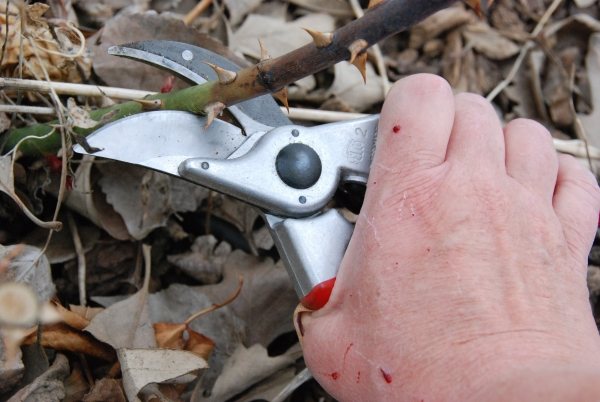

Cardinal and medium pruning is harmful to scrubs and can weaken the plant.
We cut off last year's inflorescences from the bush (about 25 - 30 cm, to a developed bud), remove damaged branches, or shoots directed into the bush. It's enough.
After 5 years, to update an adult bush, old woody shoots are cut out at the headquarters.
Since the group of scrub combines very different in shape and size plants, you can indicate only an approximate scheme for the formation and pruning of a bush:
- half-leafed species of headquarters with erect shoots can be shortened in half to initiate the growth of the lower stems, and the plant is not bare in the lower tier;
- wide branched bushes - 1/3 of the length;
- bushes with arched shoots - for 1/4 shoots;
- soil shrubs are pruned to a minimum, except when the bushes are planted too close and the branches interfere with each other.
A tall scrub, planted as a tapeworm on an open lawn, is cut unevenly: the side shoots are shortened more, the central branches are smaller.
Gentle pruning is applied to the scrubs, and it is best done in the spring.
Roses will respond with generous flowering to feeding with phosphorus-potassium fertilizersconducted twice a season - in spring and autumn.
For the winter, plants should be spud, young bushes (up to 3 years old) must be covered for the winter. In the future, many varieties will not require this. It will be enough to mulch the bush with high quality for winter.
Large bushes are undermined for the winter, laid flat on spruce branches, covered with mulch on top, or covered with spruce branches. Cover with agrofibre on top, or cover with earth.
For the winter, the plants should be spud, young bushes (up to 3 years old) must be covered
Fertilizer
Scrubs, like all rose groups, need fertilizer. For this, complex fertilizing is used, including nitrogen, phosphorus and potassium fertilizers. In doing so, it is important to observe the following principles:
- In early spring, nitrogen components should prevail in complex fertilizer. They are responsible for the growth of shoots and leaves.
- During the period when buds appear in dressings, the proportion of nitrogen components is greatly reduced. Phosphate and potash fertilizers are given in equal proportions. The plant needs more buds, and this requires strong roots.
- In the second half of summer, nitrogen fertilizers are generally abandoned. Leave only phosphorus-potassium supplements. At this time, it is no longer necessary to stimulate the development of additional shoots and flowers.
For feeding, you can choose purely organic or only mineral fertilizers. But in the first case, it is difficult to dose the amount of specific components. It turns out by eye. And in the second, soil salinization occurs, soil bacteria die, the plant cannot assimilate the components added to the ground. The best option is to alternate one with the other.
Plant reviews
In most cases, growers are very pleased with scrub roses. On the Internet, you can read a huge number of enthusiastic words about this type of flower.
Below are just a few of them:
- Valentine, 50 years old: “I have been growing flowers in my summer cottage for more than a dozen years. The most favorite among them are shrub roses, as they perfectly tolerate my absence at the dacha on weekdays and during the cold season. At the same time, they delight with a large number of fragrant buds throughout the summer. "
- Svetlana, 35 years old: “Recently we moved with my husband to a village house. I wanted to decorate the site with bright colors. Colleagues gardeners advised to buy shrabs, since caring for them is within the power of a novice florist. My bushes are 3 years old - they bloom beautifully, perfectly withstand 30-degree frosts and the frequent lack of watering in the summer. I can safely recommend them to all rose lovers. "
- Vladimir, 65 years old: “After retirement I moved to the village. He was always fond of floriculture, so he decided to plant his own garden. First of all, I bought different varieties of roses, but most of all I liked the shrubs - they bloom from the first days of summer until late autumn. At the same time, while working in the garden, I enjoy the spreading fragrance. Neighbors often ask for seedlings. Wonderful flowers. "
Fertilizing and watering plants
Now let's talk about the key features of watering and fertilizing. You will need to water the flowers every week. They love moist soil, but they categorically cannot stand strong stagnation of moisture. One bucket of water per bush will be more than enough. English roses do not accept when water gets on the leaves - a dangerous fungus can appear on them. With improper watering, the sprouts will grow poorly, and there will be much less flowers.
Without exception, all types of roses are watered early in the morning or after 7 pm. After each watering, the bushes loosen and huddle.
When it comes to fertilization, the first step is to use peat soil or compost. This will significantly slow down the drying of the soil. In the spring, when the buds are being set, it is highly recommended to fertilize English roses with nitrogen - especially if the variety is belvedere rose. In summer, potassium and phosphorus are recommended, which ensure flowering and rapid growth.
But what about the manure? It is recommended to apply it in a rotted form every 2-3 years. To strengthen the stems of the roses, be sure to add some potassium before wintering.
Preparing for landing


Roses of this group are easiest to plant with seedlings obtained independently or purchased in a store. Planting is carried out from the second half of September until the beginning of frost. The planting material should be free of mechanical damage, traces of rot and other signs of disease. The root system must be healthy and well hydrated, which is important to accelerate rooting.
Some growers soak the seedlings in water a day before starting work in order to prepare the roots.Even during the purchase of planting material, you need to carefully study the photo and annotation in order to accurately plan the location for the location.
Approximately 10-14 days before planting, you need to carefully dig up the site, and then add organic matter to the soil at the rate of 5-6 kg / m2. Mullein is the best fertilizer, but can be replaced with bird droppings or peat. In an unfavorable climate with low soil quality, it is recommended to apply complex fertilizers with a high content of phosphorus and potassium.
Planting process: digging the ground
Landing in open ground is a responsible and important matter, for which you should prepare in advance.
Two weeks before planting, the area set aside for roses should be enriched with fertilizer (compost, peat, humus, ash) and thoroughly dug up the fertilized soil.
The next step is to dig a square hole (50 x 50 cm). The depth of the ditch should be sixty centimeters. The size of the rhizome should also be taken into account here. If the indicators are higher, then the pit should be larger.
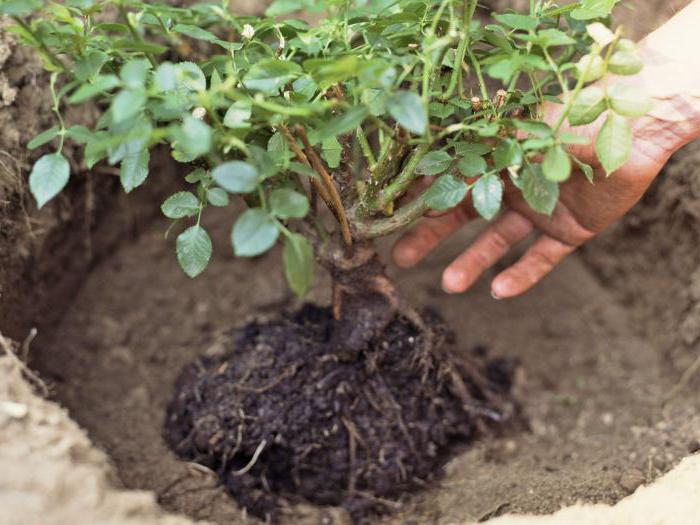

And then the fun begins. The hole is covered with dug earth, filling the void by one third, and half a bucket of water is poured into it along with a special fertilizer for roses.
After the water is absorbed, the plant itself is planted, placing it in the middle, right vertically to the ground line.
You should fill the hole with your hands, slightly compacting the place so that you get a depression of five to six centimeters.
After that, it is important to mulch the bush, and tamp the earth around it.
So, the first thing is done - our rose scrub has been planted. What to do next?
Photo
Load more photos
Classic
Other types of scrubs include classic varieties such as Romance, Fluorescent, Magnet Schrab, La Villa Cotta, Belvedere and others.
Romance is a delightful shrub one and a half meters in length, with bright pink flowers and a pleasant rich aroma. The plant is incredibly hardy in relation to heat, frost and bad weather.
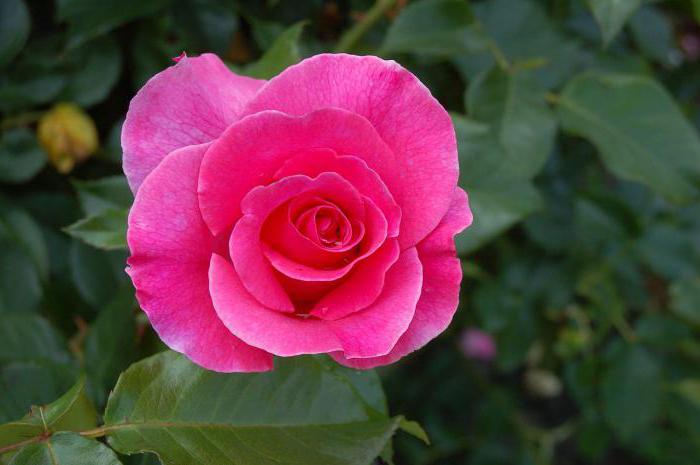

The fluorescent is marked by bright red, crimson buds, without any sign of aroma or fragrance.
The Shrab magnet, on the other hand, is characterized by a delicate pink color and a pleasantly rich aroma. The petals of the buds are wavy and smooth.
La Villa Cotta is a charming variety with an unusual color. From the inside, the petals have a burning copper color, and from the outside they are pale pink. Such a contrast is set off by green, like glossy, leaves and stems. The aroma of roses is delicate, the bush itself has an erect position and is stable against various diseases, frost and heat. Nevertheless, it is quite difficult to take root in a new place.
Belvedere is distinguished by very large peach-colored flowers and a pleasant tart aroma, but it is susceptible to many pests and diseases.
Flammentants is a climbing hybrid with huge double flowers of crimson color. Differs in early, multiple and abundant flowering.
Morden Centennial also strikes with large double buds up to ten centimeters in diameter, continuous flowering and pink-crimson color.
As you can see, all shraba roses delight and captivate with their charm and grace.
What is the secret of growing them?
What it is?
Rose shrub (from the English shrub) is a flowering shrub that can easily endure cold winters. At the same time, some varieties, for example, the Canadian scrub rose, can easily withstand 40-degree frosts. Plants of this species belong to the category of parks and are widely used by specialists in landscape design and landscaping. Today, the number of varieties of rose-scrubs is several dozen. Experts conditionally subdivide them into three categories, each of which contains plants with similar morphological characteristics. The classification is informal and is used only to structure data when describing varieties.
- The first group includes English shrub roses, bred by the famous British breeder David Austin at the end of the last century. Their distinctive feature is the unusual "English" shape of the flower, for which the plants received the unofficial name "nostalgic roses". Individuals of Bourbon, Damascus and French roses, as well as specimens of modern varieties of hybrid tea roses and Floribunda were taken as parental pairs. English shrub roses are distinguished by their unsurpassed aroma, long flowering times and powerful buds. The group includes a large number of hybrids with different growth rates and shoot heights.
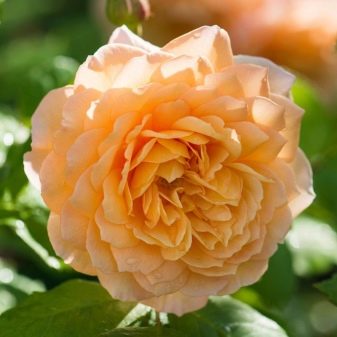

- The second group includes ground cover roses, the height of which can vary from 20 cm to 2 m. Shrubs belonging to this group can be creeping or drooping. They are distinguished by high decorative properties and unpretentiousness. During flowering, the plant covers the ground with a lush carpet, giving the garden space an elegant look.
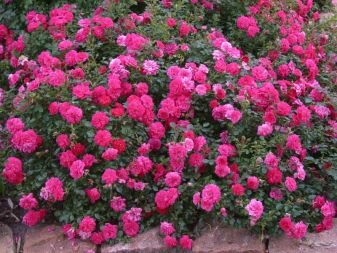

- The third group of rose scrubs is represented by plants Canadian selectioncapable of withstanding temperatures down to -40 degrees. This category is the most frost-resistant and most common in areas with a temperate and sharply continental climate.
In addition to the obvious differences, there are also a number of features that are characteristic of all plants of a given species.
- Shrub roses are characterized by continuous flowering, which begins in early June and ends with the onset of the first frost. Flowers replace each other throughout the growing season, thereby increasing the decorative properties of the shrub. The only exception is the variety "Fritz Nobis" (lat. Fritz Nobis), which is a single flowering plant.
- The species is distinguished by a wide variety of inflorescences, among which there are both classical shapes and textures, and buds that are completely unusual in their color and structure.
- Almost all varieties of rose scrubs have a bright and rich aroma, thanks to which the shrub literally smells fragrant throughout the entire flowering period.
- Frost resistance is one of the most important qualities of a shrub, which favorably distinguishes it against the background of other types of garden and park plants.
- Shrub roses are immune to most diseases typical of other types of roses, which, combined with their absolute unpretentiousness, makes them the best option for novice gardeners.
- Bushes of almost all varieties are distinguished by their density, power and volume, and some specimens reach 2 meters in height and often act as the main decoration of the garden.
- Shrub roses go well with any other types of roses, they can be grown with them in the neighborhood without fear.
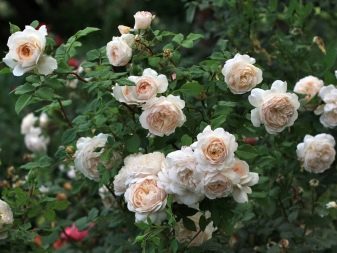

Despite the fact that shrub roses have many advantages over other decorative species, the shrub still has disadvantages. These include the need to shelter plants for the winter and regular pruning.
Wintering
For successful wintering of scrubs, it is necessary that they can enter the winter correctly, go through all the stages of their physiological preparation for a state of dormancy. Therefore, in the second half of summer, you do not need to bother them with unnecessary attention, that is, do not feed them too much, do not water, do not cut them off.
In early October, they need to be fed with phosphorus-potassium fertilizers. If you grow winter-hardy varieties of scrubs, and you yourself live in a climatic zone in which winters are not very harsh, then the bushes do not need to be covered. It is enough for them to pass the natural hardening procedure and high hilling. The best cover for them will be high snow cover.
Winters are not always snowy, so it makes sense to provide additional shelter. To do this, use spruce or pine spruce branches, dry oak leaf, and cover with lutrasil on top.
In tall and climbing bushes, branches are bent to the ground. If they are not flexible, then you can dig in the roots a little from the opposite side of the fold.The branches are laid on spruce branches so that they do not rot in the event of the formation of melt water. They are fixed with hairpins, otherwise they will tend to return to their original position. Spruce branches are placed on top and covered with non-woven material, lutrasil.
Roses with long climbing branches, entwining garden architectural structures, are not removed. They are covered directly on structures.
Park roses
It is the oldest group with a rich and interesting history. Considered in Russian, the term "park roses" is used for flowers that tolerate winter well without shelter.
Reference! The park rose varieties (namely, the white Rosa Alba and the red Gaulish) were symbols of the Dukes of York and Lancaster, whose strife resulted in the Thirty Years' War, better known as the War of the Scarlet and White Rose. According to legend, they were brought to a truce by a gardener, who crossed both species, getting a new one - Rosa mundi, with beautiful red and white petals.
Park roses are divided into three main subgroups:
- cultivated species of rose hips;
- old;
- hybrids are modern varieties obtained as a result of selection.
All of them require space and large areas, as they grow in tall and wide bushes. These plants are distinguished by early flowering, which lasts up to a month, and in some varieties even longer. Their buds are pleasant to the touch, slightly rough, in addition, they hold the record for the number of petals: there can be from a hundred or more of them.
Also, park roses are divided into those that bloom once, and those that can bloom multiple times. The first ones are suitable only for private plots where it is possible to update the plant every year. But their advantage over the latter will be increased resistance to cold - some varieties do not even need to be covered for the winter.
Such flowers are demanding for proper watering and care, therefore, before planting them, you must read all the information on this topic.
Scrub Care: Pruning
It is necessary to cut the bushes for both medicinal and decorative purposes. First of all, you should remove weak, damaged and dried branches. This is best done in April, after the snow has melted.
You need to leave five strong stems with no more than eight buds. It is also important to prune them for better development and flowering. However, the stems should be shortened by less than half their length.
After five years, you can rejuvenate the bush: cut off the old stems more than half, and the young ones a little less.
Also, trimming can be done in accordance with the intended design. Shrub roses are very responsive and resistant to any intricate shape that a gardening artist will give them.
What is remarkable about pruning an English rose shraba? Caring for such shrubs is no different from ordinary ones. The only thing that can vary is the length of the stems left. English shrubs should be cut as short as possible, even twelve centimeters.
Shrubs - features and external characteristics
The shraba variety has several characteristics. This is one of the few species that is valued not for the attractive appearance of a single flower, but for the long flowering of a large number of flowers. Below are 7 more features:
- Varied color of buds. Indeed, you can see bright scarlet, brown and even lilac hues. But there are also striped, variegated petals.
- Unusual shape and size. You can find semi-double, small-flowered, double varieties. And this is not the limit!
- As for the leaves, their shades are no less interesting - there are even burgundy leaves. The fruits are decorative, even the thorns look very picturesque.
- The flowering is plentiful and intense. The first flowers appear at the end of May, the petals fall only in September.
- Just fantastic aroma of most varieties.
- Without exception, all varieties grow quickly enough - in one growing season they can reach 150 cm.The bushes are quite graceful, have flexible branches.
- Winter hardiness. In addition, planting and leaving scrubs is not particularly difficult. For the winter, you can simply cover them for the winter, and some English and Canadian roses can withstand frosts of -30 degrees without any problems. The only feature that can cause difficulties for novice gardeners.
Growing features
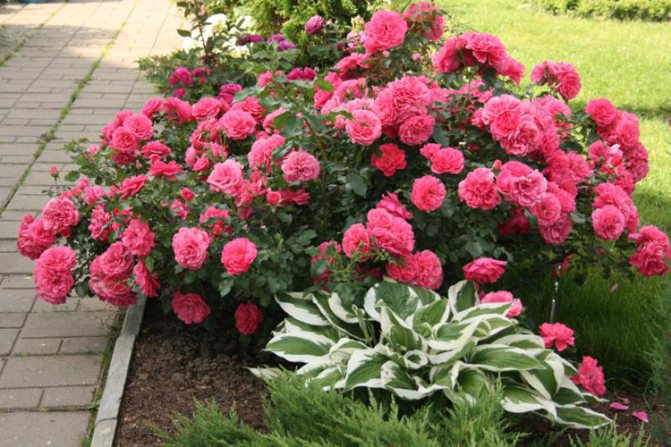

Shrubs are highly resistant and have strong immunity. Infection usually occurs only against the background of non-observance of cultivation techniques, care and when planting in excessively moist soils. In this case, there is a risk of fungal diseases, for example, powdery mildew, spotting or spheroteca. In case of detection of signs of the disease, it is necessary to cut off all the affected parts of the bush, carry out a comprehensive treatment with a fungicide.
Pests are more common, usually garden beetle or crimson weevil, aphids and spider mites rarely affect roses. Usually insects live in buds, and after their complete destruction they move to other parts of the plant. As a measure of control and prevention, complex organic insecticides of a wide spectrum of action are used.
Shrubs have become a real symbol of prosperity and tidiness of the site. They allow you to create a unique floral arrangement that will delight you almost all summer. Caring for them is simple, plants rarely get sick and do not need a lot of fertilizers. When growing, it is important to correctly select the variety and place the bush in the optimal place for the culture.
Landing (step by step instructions)
Before you start planting scrubs, you need to decide on the landing site and the expected result.
Recommendations for planting rose scrubs:
- In most cases, shrubs do not need support, so they can be planted with equal success both in a single version and in a complex of several plants;
- When creating tapeworms, shrub varieties are chosen that bloom profusely throughout the summer, exude a light aroma, and at the same time the bush has a beautiful shape, one of the best varieties is Décor Arlequin;
- Décor Arlequin When planting shrubs in groups, you can hide the imperfections of each individual bush, as well as create the appearance of a blooming ball; plants should be planted at a distance of 0.5-2 m - it depends on the width of the branches of the bushes;
- As a rule, for 1 sq. m planted 2-3 bushes;
- English roses are often planted in the form of a triangle at a short distance from each other, in this case it is possible to achieve the visibility of one large bush;
- Large bushes may have a bare lower part of the trunks, to hide bare trunks and branches, you can use undersized or ground cover roses.
Sequence of planting roses:
- When planting, it is important to ensure that the roots do not touch the compost. Seedlings are planted in mid-April, when the soil is already warm enough and the air temperature does not drop below + 12 ° C.
- The landing hole is prepared in advance. Its dimensions should be equal to 0.5x0.5x0.5 m.
- The bottom of the pit is lined with fertilizers - it can be manure or humus.
- The roots of the rose are slightly pruned, after this procedure the bush will grow better.
- When planting, make sure that the grafting of the plant is 10 cm below the ground level.
- A small mound is formed on the surface near the stem of the rose, which is removed after a few weeks. The seedling is watered.
- The stalk is cut, leaving only 2-3 buds.
In the garden decor


Scrub rose varieties can play a different role in the horizontal or vertical decoration of a garden or a recreational area. It all depends on the height, width and growth characteristics of an individual representative.
They can be used to diversify walls, obelisks, trellises or other supports, as they can serve as climbing views.
Shrubs form a fascinating hedge, fence. They will fill the garden with strong aromas, rich in pollen and bright fruits in the fall, contain a lot of vitamin C and are food for birds.With the help of scrub bushes, you can embody any ideas, create an overflow of tones, contrasting spots against the background of a solid and rainbow range of colors.
As a subset of scrubs, ground cover seedlings will cover the ground with a thick carpet, abundant buds, filling in any exposed gaps in the site. Semi-growing rose varieties are well suited for tapeworms or single plantings, especially if it is a good, large shrub with an excellent habit. You can decorate a flower bed, lawn, rocky area, slope with a scrub. They can serve as a single or mixed group. The varieties of the species are also suitable for container culture, on the balcony, on the terrace, since they form dense, dense layers-bushes. Rose shrubs fit well into any composition, for different types of landscape and growing conditions.

